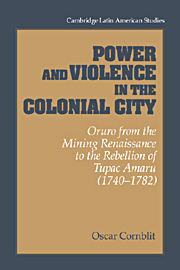 Power and Violence in the Colonial City
Power and Violence in the Colonial City Book contents
- Frontmatter
- Contents
- List of figure, maps, and tables
- Preface
- Map 1 Present-day Bolivia and surrounds
- Map 2 Principal routes of the Viceroyalty of Peru (second half of the eighteenth century)
- 1 Oruro between two epochs: a mining cycle
- 2 Under Spanish law
- 3 Oruro in 1741: details of a stormy election
- 4 The people
- 5 “Madmen, comedians, and hypocrites”
- 6 Captains of shipwreck
- 7 Returning to the known
- 8 “The fruits of the earth”
- 9 The end of an epoch: the Indian uprisings of 1780–1781
- 10 Oruro in the economic and geopolitical context of the epoch (c. 1780–1781)
- 11 The Oruro uprising
- 12 The voice of the rebels
- 13 Picking up the pieces
- Appendix A Indian raids on Oruro, 1781: testimonies
- Appendix B Testimonies of inhabitants of the city
- Appendix C Table of public jobs in Oruro, 1730–1784
- Bibliography
- Index
- CAMBRIDGE LATIN AMERICAN STUDIES
7 - Returning to the known
Published online by Cambridge University Press: 30 March 2010
- Frontmatter
- Contents
- List of figure, maps, and tables
- Preface
- Map 1 Present-day Bolivia and surrounds
- Map 2 Principal routes of the Viceroyalty of Peru (second half of the eighteenth century)
- 1 Oruro between two epochs: a mining cycle
- 2 Under Spanish law
- 3 Oruro in 1741: details of a stormy election
- 4 The people
- 5 “Madmen, comedians, and hypocrites”
- 6 Captains of shipwreck
- 7 Returning to the known
- 8 “The fruits of the earth”
- 9 The end of an epoch: the Indian uprisings of 1780–1781
- 10 Oruro in the economic and geopolitical context of the epoch (c. 1780–1781)
- 11 The Oruro uprising
- 12 The voice of the rebels
- 13 Picking up the pieces
- Appendix A Indian raids on Oruro, 1781: testimonies
- Appendix B Testimonies of inhabitants of the city
- Appendix C Table of public jobs in Oruro, 1730–1784
- Bibliography
- Index
- CAMBRIDGE LATIN AMERICAN STUDIES
Summary
Although an analysis of the years between the events related in the previous chapter and the uprising of 1781 does not form part of this study, a summary of the period extending until just past the first half of the century is helpful to prepare for what follows.
The term of the corregidor Juan de Landaeta went against the grain of Oruro's high-strung society, and the town endured it with scarcely concealed impatience. When the next corregidor, Eugenio Lerdo de Tejada, took office, the town reverted to its interminable quarrels, mutual accusations, and factional hostility.
Melchor de Herrera – unshakable in his post as alcalde provincial – reappeared on the scene with no need for discretion. His office was strategic in that its holder gave orders to the rural police. As noted in the preceding chapter, the possibilities for wielding effective power depended in this case, as in that of alcalde ordinario or corregidor, on the private resources of the individual who had the job. In some cases it was also possible to arbitrarily make use of the resources of the royal exchequer. The opposition to Herrera's group seemed more disorganized in this period, his main enemies being the corregidores and people sent from Lima. But the weak authority of the latter – compared to the firm discipline of Juan de Landaeta – caused the viceroy to adopt a somewhat tolerant position toward the Herrerists and their followers.
- Type
- Chapter
- Information
- Power and Violence in the Colonial CityOruro from the Mining Renaissance to the Rebellion of Tupac Amaru (1740–1782), pp. 81 - 91Publisher: Cambridge University PressPrint publication year: 1995


